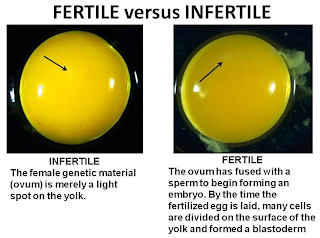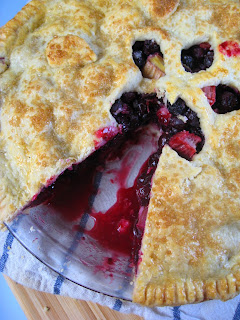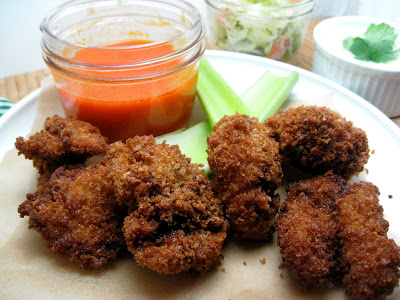Not sure if you should get the organic cage-free eggs, or the free-range omega-3 eggs, or the vegetarian brown eggs? Do you need jumbo eggs or will medium eggs work? All the labels on eggs in the store can be hard to decipher, here's what you need to know before you buy eggs.
Packing Dates
Freshness of the eggs is one of the most important factors when it comes to the quality and nutrient content. Eggs inspected and graded by the USDA will have a three digit number representing the date they were washed and packed stamped on the carton. The
Cook-It-Quick food safety website says "The number is a three-digit code that represents the
consecutive day of the year (the "Julian Date") starting with January 1
as 001 and ending with December 31 as 365. When a "sell-by" date appears
on a carton bearing the USDA grade shield, the code date may not exceed
45 days from the date of pack."
Egg Sizes
The USDA grades egg size by weight, calculated by the minimum acceptable weight per dozen. Sizes of the eggs may vary but the weight should be consistent. Most recipes call for large egg which are at least 24oz per dozen or about 2oz per large egg. Here's a handy chart made by the American Egg Board:
Egg Grades

Egg grades reflect the quality of the eggs as determined by USDA
standards and inspection. There are three grades of eggs - AA, A and B,
with AA being the highest quality. The quality is determined by
inspecting both the shell and the interior of the egg for defects such
as discoloration, cracks, and irregularities. The
USDA website says US
grade AA eggs "have whites that are thick and firm; yolks that are high,
round, and practically free from defects;
and clean, unbroken shells." Grade A eggs are different from
AA eggs in one way, instead of "thick and firm" whites they have
"reasonably firm" whites. Grade A eggs are what is most often sold in
stores. Grade B eggs are typically not sold in stores, but are used to
make egg products. If you do find Grade B eggs being sold, they are fine for general cooking and baking, but not ideal for poaching or other uses where the visual of the egg is important.
Egg Colors
There's no nutritional difference between different color eggs. The coloring is determined by the breed of the chicken - white eggs are laid by white chickens, brown eggs are laid by red chickens, and blue eggs are laid by a special South American breed of chicken called the Arucana. Brown eggs generally cost more because the chickens that lay them eat more. Blue eggs are not available in most places in the U.S.A.
Yolk color can vary depending on the feed of the hen. Organic pigments called carotenoids determine the color of the yolk, the main two yellow carotenoids in eggs being lutein and zeaxanthin. There are also carotenoids in eggs that have a orange or red color. Eggs sold in US stores will pretty much always be golden yellow, but don't be freaked out if they are darker. This chart won't affect how you buy eggs, I'm just a nerd who loves charts.
The egg white will be slightly more opaque and thicker when the egg is fresh. As the egg ages the carbon dioxide dissipates and the white will become more clear and watery.
Cage
Most eggs are produced by chickens in cages. Caging has many benefits for the producers - automation reduces the amount of physical labor, workers are exposed to less dust and ammonia, minimized contact between the hen and their feces and the eggs and the hen significantly reduces the chance of bacterial infection of the eggs, and it increases production. Unfortunately, caging has many negative side effects for the hens - not being able to move around and engage in normal chicken behavior causes diseases of the body and behavioral problems in the chickens, to the extent that many caged chickens have the tips of their beaks cut off, so they don't attack each other through the cages. Cage eggs are the cheapest, but many people have ethical problems with their production so there is a growing market for eggs from chickens raised in less factory like settings.
Cage Free/Barn Laid
A cage-free egg is from a chicken that was raised indoors, but was allowed to roam around within an enclosed space. Hens are protected from predation and inclement weather, and still can engage in normal chicken behavior and socialization. There is a slightly higher chance of infection because the chicken feed can come in contact with their feces. Cage-free hens are able to walk, spread their wings and
lay their eggs in nests, natural behaviors that caged hens cannot engage in. However, cage-free does not necessarily mean cruelty free. Many cage-free hens are raised in flocks of thousands, never go outside, and like the hens in cages, some producers clip their beaks and, although most producers no longer support the practice, some still use starvation to force molt their birds. Cage-free is terminology designed to quell consumers concerns - it sounds better than "high-density floor confinement" which is the industry term for it.
Free-Range
In the United States, eggs marked as "free-range" can be slightly misleading. When most people imagine a free-range chicken roaming around the yard hunting and pecking, what they are actually imagining is a different farming practice called "yarding". While "free-range" has a legal standard for meat production, there are no guidelines for free-range eggs. All that is required for an egg to be marketed as free-range is for the chickens to have access to an outdoor range. There is no standard for how large the range is, or how much pasture the chickens get, or how much time outside they spend. Many free-range chickens are provided a small, fenced in, gravel covered area immediately outside the barn door, and are kept indoors for a significant part of their lives. Over time the ground the chickens have access to becomes polluted and acidic from a build up of chicken waste, causing damage to the local ecology.
Pasture-Raised
Because of the ambiguity of the term "free-range" farmer Joel Salatin has reintroduced the term and technique of pasture-raising chickens at his family farm in Virginia, the Polyface. Pasture-raised birds remain outside on pasture at all times, confined to a portable pen and given a covered area to protect them from the weather. When waste begins to build up, the chickens are moved to another part of the pasture. The Polyface farm has been praised for being humane and ecologically sound, and the practice has spread to other sustainable farmers. There is some evidence that pasture-raised hens produce superior, more healthful eggs than factory hens.
According to tests, pasture raised chicken eggs may have 1/3 less cholesterol, 1/4 less saturated fat, 2/3 more vitamin A, 2 times more omega-3 fatty acids, 3 times more vitamin E and 7 times more beta-carotene than what is considered the normal nutritional content of an egg as determined by the USDA. This is probably due to having a more varied diet consisting of more natural, foraged foods such as green grasses and insects.
Pasteurized
Pasteurization is the process of killing dangerous microorganisms in food by applying controlled heat for a short time. Until recently, heating egg to the temperature required for pasteurization would cook the egg. In the 1990s the process for pasteurizing eggs in shell was developed and patented, and currently
National Pasteurized Eggs Inc. is the exclusive provider of pasteurized eggs in the USA. The process can be duplicated at home by use of a temperature controlled water bath.
Pasteurized eggs are recommended for applications where the egg won't be cooked, for example in mayonnaise. In fact, the USDA won't allow sale of any food products with unpasteurized raw eggs. Pasteurized eggs are sold clearly marked with a red "P" stamp.
Fertilized vs. Unfertilized
The only real difference between a fertilized and unfertilized egg is that a rooster has been involved. Hens will lay eggs whether they have mated or not, and the vast majority of eggs sold are unfertilized. Most hens at commercial farms are never around roosters. Fertilized eggs are more likely to come from a free-range farm. All eggs sold as food within the United States must be refrigerated, and the refrigeration halts any embryonic growth within the egg. Some people claim there are additional health benefits to eating fertilized eggs, but nutritional studies have found no discernible difference. Eggs sold in the US go through a process called candling in which a light is shown through the shell, revealing imperfections in interior - this process screens out defective eggs and highlights irregularities, so you don't have to worry about cracking open an egg and finding a half formed chicken inside. Eggs are normally harvested and refrigerated within a few hours of being laid, and it takes about 21 days for a chicken egg to fully develop and hatch.

Nutrient Enhanced
There are many specialty eggs on the market that are nutrient enhanced, the more common types being low cholesterol eggs, eggs enriched with omega-3s and eggs enriched with lutein. All of these changes to the eggs nutritional content are effected by changing the feed of the chicken. Chickens producing "low cholesterol" eggs are fed an all-vegetarian diet high in protein, fiber and vitamin E. Chickens producing omega-3 enhanced eggs are fed diets rich in omega fatty acids like flax seeds, insects, greens, and fish oil. There is controversy as to whether these more expensive eggs are worth the price tag. Neither low cholesterol or omega-3 enhanced eggs have proven health benefits over regular eggs. Lutein enriched eggs are made by feeding the chickens food supplemented with marigold extracts. Lutein is vital for eye health and diets rich in it have been shown to help with age related vision loss, especially macular degeneration.
Studies have shown that the lutein in lutein enhanced eggs is more bioavailable than lutein from supplements or other sources. Nutrient enhanced eggs are not necessarily from humanely farmed animals, the label has nothing to do with the conditions in which the chickens are kept.
Vegetarian
The term "vegetarian eggs" may be a bit confusing, but what it comes down to is that the eggs are from vegetarian chickens - that is, chickens that where given no animal byproducts as part of their feed. Chickens are not natural vegetarians, left to their own devices they will supplement their diet with grubs and worms and insects. The market for "vegetarian" eggs arose from the Mad Cow disease (transmissible spongiform encephalopathies) scare. Contraction of TSE is linked to cannibalism and eating infected brain tissue, and at the time of the outbreak many chickens where being fed chicken parts along with their normal soy, corn and grain diets. A egg labeled vegetarian did not necessarily come from a farm with humane conditions for its chickens. The easiest way to keep a chicken on a strict vegetarian diet is to place it in a
battery cage, perhaps the most inhumane way to raise the animals. Free-range chicken eggs may be sold as "vegetarian" by farmers who don't provide any animal by products in their feed, even though those chickens are supplementing the provided feed with foraging for bugs.
Organic
Much like the "vegetarian" label, the "organic" label on eggs is misleading, and for the most part a marketing gimmick. Typically the only difference between and organic egg and a regular egg is that the chickens were given organic feed, and hasn't been given artificial hormones or other chemicals. Chickens fed organic food are often still housed in large sheds packed in with a thousand other birds.
Other Eggs (non-chicken)
Sometimes you can find other kinds of eggs available, more often at farmers-markets than at super-markets. Duck eggs are bigger than chicken eggs, and very nutritious. They have a harder shell than chicken-eggs and a longer shelf life if stored properly. Duck eggs are naturally high in omega-3 fatty acids. Duck eggs are rumored to be better in baked goods where the higher quantity of albumen in the whites makes cakes and pastries fluffier than when using chicken eggs. Quail eggs are considered a delicacy in many parts of the world. They are much smaller than chicken eggs and have spotted shells. Quail eggs are much more nutritionally dense than chicken eggs. Many other types of eggs are edible, but most of them aren't typically sold.












































